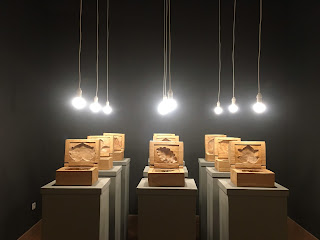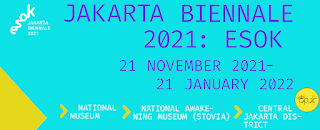Top Stories about Art, Beauty, and Japanese Doll
Ningyo
Art and
Beauty of Japanese Dolls
The Japan Foundation Travelling Exhibition
Organized by: The Japan Foundation
Supervised by: Hayashi Naoteru (Japanese doll culture research institute) &
Mita Kakuyuki (Tokyo National Museum)
In Jakarta
06 - 24 July 2023
09:00 - 19:00 WIB
Galeri Nasional Indonesia
“Japanese doll as the prayer for children development, Japanese doll as the art
and Japanese doll as the folk art.”
These dolls represent close female servants to the Emperor and Empress from the
Edo period (1603-1868). The implements held by each are items used in ceremonies
such as weddings.
The one in the middle holds the Shimadai, a platform on which sake cups are
placed. On the right is the Nagae no Choushi, implement used to pour the sake
into the cups, while on the left is the Kuwae no Choushi, a container used to
pour more sake into the Nagae no Choushi when it runs out.
These dolls represent a grandfather and grandmother as the lead characters from
a traditional Japanese No play called Takasago, They are often offered as gifts
when babies are born to share their good fortune so that they are healthy and
long lived.

Kabuki Ningyo: Renjishi
(Two lions)
Kiyomura Yoshihide
2020
These are dolls representing characters from a traditional Japanese Kabuki
theater. These dolls represent parent and child lions in human form.
The white-haired doll is the parent, and the red is the child. In the East, the
lion is seen as the king of animals and believed to have the ability to
vanquish evil, so the dolls are often offered as gifts to pray for the
happiness of a newborn baby, and that they do not become sick or injured.

Musha Ningyo: Taisho
(Armored warrior)
Matsuzaki Koikko
2020
This doll is displayed for the celebration of Tango no Sekku, or Children's
Day, on May 5th to pray for the happiness of male children. Among the
armor-wearing Musha or Samurai, Taisho symbolizes those who are strong and
wise. It is often offered as a gift to pray for male children to grow up
distinguished and in good health. Japanese armor emphasized aesthetic beauty in
addition to practical protection, and thus represent the intersection of
traditional arts and craftsmanship.

Momotarô
Matsuzaki Koikko
2020
Momotaro is a hero from a Japanese folktale that describes how he was born from
a peach, and grew up to travel to the island of the ogres, accompanied by a
dog, a monkey, and a pheasant, to take back the treasures the ogres had stolen.
In his left hand, Momotaro holds a bag of sweets called kibi dango that he gave
to the dog, monkey, and pheasant to get along with.

Gosho Ningyo: Treasure ship
Gosho Ningyo: Crane
Nakamura Shinkyo
2020
The term Gosho refers to the Japanese imperial court. These dolls were loved by
the members there from the Edo period (1603-1868), and were offered as gifts
for a variety of celebratory occasions. They depict plump and healthy babies
with smooth white skin, representing beauty, purity and honor. They are holding
a treasure ship that brings good fortune, or crane that signifies long life, in
their hands, with auspicious images of treasures on their waistcoats.

Saga Ningyo: Enmei fuku no Kami
(God of happiness and longevity)
Nakamura Shinkyo
2020
Saga Ningys are notable for the gold leaf and paint applied in minute detail to
their clothing, making them one of the most luxurious among Japanese dolls from
the do period (1603-1868). This doll represents a deity who brings good
fortune, who holds a bag in their left hand from which any treasure can be
brought forth.

Keshi Ningyo: Dairi-bina
Keshi Ningyo: Butterfly dance
Yamada Yuji
2020
The term Keshi means something very tiny like a poppy seed. These tiny and
delicate dolls became popular during the do period (1603.
1868) in reaction to an edict by the Tokugawa Shogunate that it was overly extravagant
for common people to own large dolls. These dolls are a miniature version of
the Dairi-bina displayed for the Hina Matsuri festival celebrated on March 3rd,
and of a traditional dance of the imperial court that represents the form of a
beautiful butterfly.


Shizuoka Anesama
Nakadaira Ikuno
2020
Made in: Shizuoka city, Shizuoka
Material: Paper
Shizuoka Anesama depict women’s appearances wearing traditional Japanese dress
and hair tied in the traditional manner. They are notable for their simple
designs featuring the white of the washi paper as an accent, without drawing a
face or coloring the hair black. Japanese girls played with dolls such as these
until about 100 years ago.

Hakata Ningyo: Miyabi (Elegance)
Tanaka Isamu
2020
Made in: Fukuoka city, Fukuoka
Material: Clay
This work depicts a Japanese woman in traditional dress putting on an overcoat
to ward off the early spring chill. The pattern of the clothing represents the
season by depicting plumb blossoms that bloom in early spring. A beautiful
woman is a very popular motif of Hakata Ningyo.

Matsumoto Oshie: Oniwakamaru
Matsumoto Oshie: Oiran and Kamuro
Mimuta Takahiro
2019
These dolls have been made in Matsumoto city, Nagano prefecture, since roughly
200 years ago. Oshie is a method to cut a thick paper along a design, wrap each
part in fabric, and combine the parts. The work with a giant fish depicts
Oniwakamaru, a boy with superhuman strength from roughly 850 years ago. The
other work depicts a top rank courtesan and her understudy. It is instilled
with a wish for male and female children to grow up to be healthy and
intelligent.

Oshie Hagoita: Danshichi
Oshie Hagoita: Oshichi
Kyogoku Kinzan
For this type, Oshie doll is attached to a paddle, Hagoita, used in a traditional
pastime like badminton. Displaying it is believed to dispel misfortune. The one
with a man represents a Kabuki play scene in which Danshichi, a gambler with
tattoo, kills his greedy father-in-law at the summer festival. The other
depicts the female Kabuki character who sets a fire, out of desperation to see
her lover again whom she
met on the day of a great fire.

Yuki no Asa (A Snowy Morning)
Haruki Tadao
2004
This work was made by forming the shape from a mix of powdered paulownia wood
and starch to be molded, then covering it with layers of whitewash made from
shells, and finally using washi paper, a special product of Japan, for the
clothing. The work depicts a woman chafing her hands in the brisk air of a
snowy morning.

Licca-chan
TOMY Company, Ltd.
(Left) 1967
(Right) 2003
This is a dress-up doll made of soft plastic. It was first released by a
Japanese toy maker in 1967, and remains popular today, though the body shape
and expression has changed slightly over the years to keep up with the fashion
of the times, which can be seen by comparing the old and new examples shown
here. Recently, Japanese girls are playing with Licca-chan in the same way as
girls did in the Edo period (1603-1868) with Ichimatsu Ningyo.

Let the pure rain fall
Igeta Hiroko
2020
This is a work of formed and baked clay. This work seems to represent the
determination and strength of wishing to be like a big cloud, a cloud that drop
pure rain on the land.

Peacefully
Taki Yasuko
2013
This work involves the application of leather onto the surface to recreate the
texture of human skin. The same materials and methods used to make actual
clothes and accessories worn by people are used, condensed into minimal form
for the work. The work beautifully captures a common moment from everyday life,
rather than a special scene from a special day.

Takasaki Daruma
Minegishi Kimitsugu
2020
Made in: Takasaki city, Gunma
Material: Paper
Daruma depicts Dodhidharma, or Daruma Daishi in Japanese, the founder of the
Zen Buddhism. It is said to bring happiness and grant wishes. The reason that
the eyes are not painted on is because traditionally, one eye is drawn on when
making a wish, and the second is only drawn when that wish comes true. The
eyebrows and facial hair are designed after the crane and tortoise
respectively, as both represent longevity.
Which one is
your favorite dolls in this time exhibition?
Comments below and tell me your impression.















Comments
Post a Comment